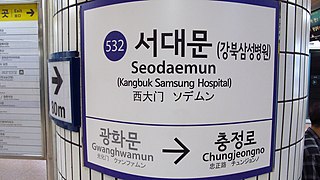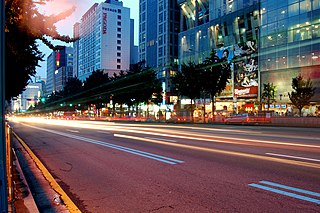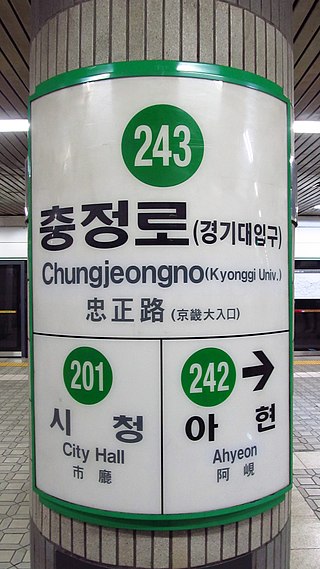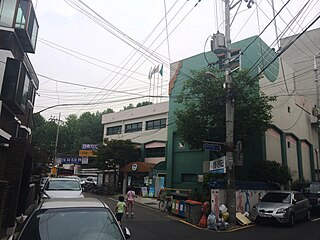
Seodaemun Station is a station on the Seoul Subway Line 5. It is named after one of the four great gates of the circular wall surrounding ancient Seoul.

Seodaemun Prison History Hall (Korean: 서대문형무소역사관) is a museum and former prison in Seodaemun District, Seoul, South Korea. It was constructed beginning in 1907.

Seodaemun District is one of the 25 districts of Seoul, South Korea.
Yeonhui-dong (Korean: 연희동) is a dong (neighbourhood) at the center of Seodaemun-gu in Seoul, South Korea. It is an area in Seoul near Yonsei university, and actually the name Yonsei comes from the combination of Yeonhui and Severance.

Chungjeongno Station (Korean: 충정로역) is a subway station on Seoul Subway Line 2 and Seoul Subway Line 5. It is located in Seodaemun-gu, which is a district in Seoul, South Korea. Chungjeong was the pen name of minister Min Yeong-hwan, who committed suicide protesting the signing of the Japan–Korea Treaty of 1905.
The Han Sang Soo Embroidery Museum is an art museum specializing in Korean embroidery located in Gahoe-dong, Jongno-gu, central of Seoul, South Korea. It was established by Han Sang Soo, who holds a title as a jasujang, a profession recognized as an Important Intangible Cultural Property by the Cultural Heritage Administration of South Korea.

Ilmin Museum of Art is a private art museum of South Korea, located on Sejongno street in Jongno-gu, a central district of Seoul, known for exhibiting mainly Korean art. The museum was established and run by the Ilmin Cultural Foundation (Korean: 일민문화재단), a non-profit organization founded in 1994 in memory of Kim Sang-man, former president of Dong-A Ilbo, one of the major newspaper companies of South Korea. Kim devoted his entire life to developing Korean journalism and promoting Korean culture. The museum is named after his pen name, "Ilmin".
The Museum of Korea Straw and Plants Handicraft is a handicrafts museum in Myeongnyun-dong, Jongno-gu, Seoul, South Korea.

The Whanki Museum is a private art museum in Jongno-gu, in central Seoul, South Korea. It was established by the Whanki Foundation mainly to exhibit and commemorate the art of Whanki Kim, one of Korea's foremost abstract painters. The museum is located in Buam-dong, close to Seongbuk-dong, Seongbuk-gu, where Whanki Kim and his wife spent many years. The atmosphere and natural environment of the two places have much in common. The museum building was designed by architect Kyu-seung Woo. Construction began in 1990, and the museum opened in November, 1992.

Sillim-dong (Korean: 신림동) is a dong (neighborhood) of Gwanak District, Seoul, South Korea. Seoul National University and Nokdu Street are located in the town. Its name means "new forest", which was derived from the woods outstretched from Mt. Gwanak. It consists 11 administrative neighbourhoods.

Sogong-dong is a dong, neighbourhood of Jung-gu in Seoul, South Korea.

Bukgajwa-dong is a dong, neighbourhood of Seodaemun-gu in Seoul, South Korea. Seoul Metropolitan City Tangible Cultural Heritage Number 41, Hwasangunsindobi, is located here.
Hongje-dong is a dong, neighbourhood of Seodaemun-gu in Seoul, South Korea.

Bugahyeon-dong is a dong, neighbourhood of Seodaemun-gu in Seoul, South Korea.
Changcheon-dong is a dong, neighbourhood of Seodaemun-gu in Seoul, South Korea. The sole Mormon Temple in South Korea is located here.
Chungjeongno-dong is a dong, neighbourhood of Seodaemun-gu in Seoul, South Korea.
Bongwon-dong is a legal dong, neighbourhood of the Seodaemun-gu district in Seoul, South Korea and is governed by its administrative dong, Sinchon-dong's office. Bongwon-dong has the Bongwon-Temple(Bongwonsa) built by Great master Doseon (827–898) in 889, 3rd year of Jinseong Queen, the 51st of Shilla Dynasty. Bongwon-Temple gives opportunities for visitors to experience "Seoul Lotus Festival" and "Yeongsamjae ritual" annually.
Sangam-dong is a legal dong (neighborhood) of the Mapo District in Seoul, South Korea. In the wake of the 2002 FIFA World Cup, a large apartment complex and DMC business district have been created and developed into the center of western Seoul.

Hapjeong-dong is a dong, neighbourhood of the Mapo-gu district in Seoul, South Korea.
Chunghyeon-dong is a dong, neighbourhood of Seodaemun-gu in Seoul, South Korea.












